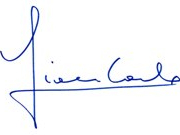“Pit talk”….2014 F.1 season and more
 All teams’ efforts are focused on the 2014 season and the difficulties they’re meeting are not a few. It’s time to take stock of the situation thanks to the support of some friends who were very close to the Minardi F.1 Team in the past and some others who constantly deal with the F.1 limelight. I’d like to go beyond technical details, which characterized many articles published on many sports magazine and I’d like to create an overview of the situation by having a “pit talk”.
All teams’ efforts are focused on the 2014 season and the difficulties they’re meeting are not a few. It’s time to take stock of the situation thanks to the support of some friends who were very close to the Minardi F.1 Team in the past and some others who constantly deal with the F.1 limelight. I’d like to go beyond technical details, which characterized many articles published on many sports magazine and I’d like to create an overview of the situation by having a “pit talk”.
The main difficulties constructors are meeting with regards to the 2014 season ( Ferrari-Mercedes-Renault) are: Engine Consumption – Engine Power – Reliability, but the real handicap is the lack of on-track testing. Nowadays tests are made inside simulator suites. Even if driving simulation is a technologically advanced method to make testing, it cannot accurately reproduce on-track reality.
Thanks to suppliers’ cooperation, reliability is getting better and better, but we’re still talking about results achieved at the test stand. The situation could change when the engine unit is installed inside the car and on-track testing is run, as it’s very difficult to reproduce on-track situations in details.
According to the information gained, it seems that the three engines’ horsepower will be in a range between 610 and 620 hp. Engine designers are more focused on consumption streamlining, rather than on trying to achieve the engine’s maximum power. The Damocle’s sword for the 2014 season will be the 100 kg- gas- limit.
Excessive consumption could be disadvantageous during the race and it seems that everybody is still looking for a right balance. According to rumors, it seems that all constructors dread tire skidding, especially when drivers shift to the 2nd and 3rd gear (engine torque – engine power distribution – tyres effect). This effect features the current Pirelli tires, so it is very important to know the 2014 tyres’ characteristics. I don’t want to say anything more about that, as everyone is trying to bring everything to line with regulations and we don’t have to forget that next season new “energy recycling systems” will be introduced: the MGU-K (the KERS) and the newborn MGU-H, which is a brand new recycling system. This system is not so easy to install and it has still to be tested. Furthermore, we don’t have to forget that the basic engine has to be ready-to-run within 4 months!
Besides talking about the 2014 racing season, I’d also like to meditate on the 2015 racing season. HONDA will join the circus by officially supplying McLaren with engine. PORSCHE could join F.1, too. Despite the German manufacturer isn’t cooperating with any team at the moment, it’s by the way testing a new engine (well-informed people say that their engine unit is not second to any other unit in terms of consumption, horse power and reliability). The two above-mentioned manufacturers have made the history of turbo-powered engine (I’d point out that they’ve always made use of that system also for what concerning cars’ manufacturing).
It seems that the Honda engine put out 640 horsepower, which is much higher than rivals’ engine’s horsepower and the consumption level is very good. According to some rumors coming from Japan, it seems that some on-track tests will be made using a hybrid chassis. The chance for Honda to test its engine throughout the 2014 season, thanks to the cooperation with McLaren and Mercedes, can turn to be a technical advantage even with a view to the 2015 season.
This is only a “pit talk” and what is certain is that there’s something brewing and we’ll see wonderful things! Next winter and spring will be red-hot.





